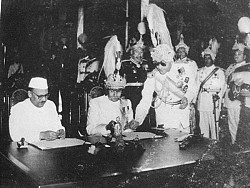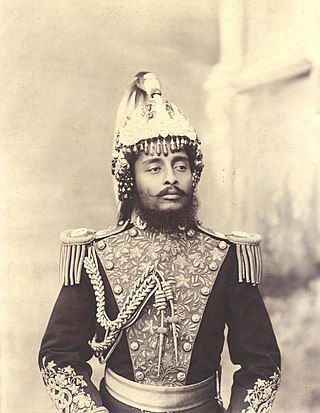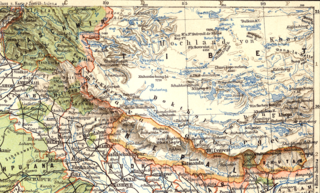
The Kingdom of Nepal was a Hindu kingdom in South Asia, formed in 1768 by the expansion of Gorkha Kingdom, which lasted until 2008 when the kingdom became the Federal Democratic Republic of Nepal. It was also known as the Gorkha Empire, or sometimes Asal Hindustan. Founded by King Prithvi Narayan Shah, a Gorkha monarch who claimed to be of Khas Thakuri origin, it existed for 240 years until the abolition of the Nepalese monarchy in 2008. During this period, Nepal was formally under the rule of the Shah dynasty, which exercised varying degrees of power during the kingdom's existence.

The Treaty of Sugauli, the treaty that established the boundary line of Nepal, was signed on 4 March 1816 between the East India Company and Guru Gajraj Mishra following the Anglo-Nepalese War of 1814–16.

Bhimsen Thapa was a Nepalese statesman who served as the Mukhtiyar and de facto ruler of Nepal from 1806 to 1837. He is widely known as the longest-serving prime minister of Nepal and was inducted into the "National heroes of Nepal" by King Mahendra Bir Bikram Shah.

The Prime Minister of Nepal is the head of government of Nepal. Together with their Council of Ministers, the prime minister exercises executive power in the country.

The 1950 India-Nepal Treaty of Peace and Friendship is a bilateral treaty signed by the Kingdom of Nepal and the Republic of India to establish a close strategic relationship between the two South Asian neighbours. The treaty was signed at Kathmandu on 31 July 1950 by the last Rana Prime Minister of Nepal Mohan Shumsher Jang Bahadur Rana and Indian ambassador to Nepal, Chadreshwar Narayan Singh and came into force the same day as per Article 9 of the Treaty. Rana rule in Nepal ended just 3 months after the treaty was signed. The treaty allows free movement of people and goods between the two nations and a close relationship and collaboration on matters of defence and foreign policy.
Nepalese literature is the literature of Nepal. This is distinct from Nepali literature, which is the literature in only Nepali language. The major literary languages of Nepal are:

Field-Marshal His Highness Maharaja Sri Teen Chandra Shumsher Jung Bahadur Rana was the Prime Minister of Nepal from the Rana dynasty. He served in this capacity from 27 June 1901 to his death in 1929 after he successfully deposed his liberal and reformist brother Dev Shamsher. Although generally perceived as despotic and conservative, he is credited with several reforms including the abolition of slavery and establishing the Nepal-Britain Treaty of 1923, which recognised Nepal as an independent nation and an ally of Britain.

The Government of Nepal is the federal executive authority of Nepal. Prior to the abolition of the Nepali monarchy in 2006, it was officially known as His Majesty's Government.

Mathabar Singh Thapalisten (help·info) was the Prime Minister of Nepal and the Commander-In-Chief of the Nepalese Army from 1843 December 25 – 1845 May 17, until he was murdered by his nephew Jung Bahadur Rana. He was the first Mukhtiyar to title himself as a Prime Minister, as per the British convention. He was the nephew of Bhimsen Thapa, who was sentenced to prison after falsely accused of the death of King Rajendra's six months old son. Mathabar Singh Thapa fled to Shimla after the execution of Bhimsen Thapa, to avoid his own execution as he was Bhimsen's nephew. Four years later, the second queen of Rajendra, Queen Rajya Lakshmi, called him back and installed him as the Mukhtiyar, paving the way for him to eventually title himself as the Prime Minister. Mathabar Singh, however, enraged the queen by refusing to make her son, Ranendra Bikram, the king. The queen, in turn, had him shot by his own nephew Janga Bahadur Rana and thereby making him the last dynast of the Thapa dynasty. Mathabir Singh Thapa was killed by his own nephew.

The Nepal–Britain Treaty was first discussed in 1921 and the final treaty was signed on 21 December 1923 in Singha Durbar. The treaty was the first formal acknowledgement by the British that Nepal, as an independent nation, had the right to conduct its foreign policy in any way it saw fit and was considered to be “a great achievement of 25 years of Chandra Shumsher’s diplomacy.” The treaty was recorded in 1925 in the League of Nations.

Dor Bahadur Bista is a Nepalese anthropologist, social scientist and activist. Bista is considered the Father of Nepali anthropology, and has published popular books such as Fatalism and Development and People of Nepal. Bista mysteriously disappeared in 1995.

Sajha Publications is the oldest publishing house of Nepal. It was established in 1913 and is funded by the Government of Nepal. Headquartered in Lalitpur, it has regional branches in Biratnagar, Pokhara, Nepalgunj and Dhangadi.

Greater Nepal is an irrendentist concept in Nepal, which claims current Indian and Bangladeshi territories beyond Nepal's present day boundaries. These claims typically include the areas controlled by Nepal between 1791 and 1816, a period that ended with the Anglo-Nepalese War and the signing of Sugali Treaty. In addition, extensive territories in present day Indian states of Uttar Pradesh, Bihar, West Bengal and some parts of Bangladesh are also included in the claims of the activist organisation Greater Nepal Nationalist Front, which demands the "return" of these territories to Nepal. A map similar to theirs was displayed by the mayor of Kathmandu in his office in June 2023, in reaction to an alleged "Akhand Bharat" map in the Indian Parliament buliding.

Gopal Parajuli is a Nepalese poet and writer. He won the Madan Puraskar prize with his epic Naya Ishwar Ko Ghoshana. He is known as a poet, short-story writer and playwright of post-modern and post-post-modern experimental vein.

Nepalese-British relations are the foreign relations between the Federal Democratic Republic of Nepal and the United Kingdom of Great Britain and Northern Ireland. Relations between the UK and Nepal have historically been friendly and there have been close links between the Royal Families. The UK is highly regarded in Nepal as a result of historical ties, development assistance and long-term support in the struggle for democratic peace in Nepal.
Bakhtawar Singh Basnyat was Mulkazi of Nepal.
Rajguru Gajraj Mishra also spelled Gajaraj Mishra was a Nepalese politician, ambassador, diplomat and a royal priest of Shah dynasty. He was always inclined to his disciple Prince Regent Bahadur Shah of Nepal. Gajraj Mishra was disfavoured by his disciple King Pratap Singh Shah due to his support to Prince Bahadur Shah. He was also disfavoured by Pratap Singh's son Rana Bahadur Shah.

Shambhu Prasad Dhungel was a Nepali author, playwright, and poet.

Surya Bikram Gyawali was a Nepali historian. He wrote biographies for numerous people including King Prithvi Narayan Shah and writer Bhanubhakta Acharya. Gyawali also served as a head teacher in Darjeeling. He is also a recipient of the Order of Gorkha Dakshina Bahu, the Order of Tri Shakti Patta, and the Tribhuvan Puraskar (1971).

Binod Prasad Dhital (1923–2007) was a poet and novelist from Nepal. He is best known for his mythological novel Yojana Gandha, for which he was awarded the Madan Puraskar and Sajha Puraskar in 1995.


















